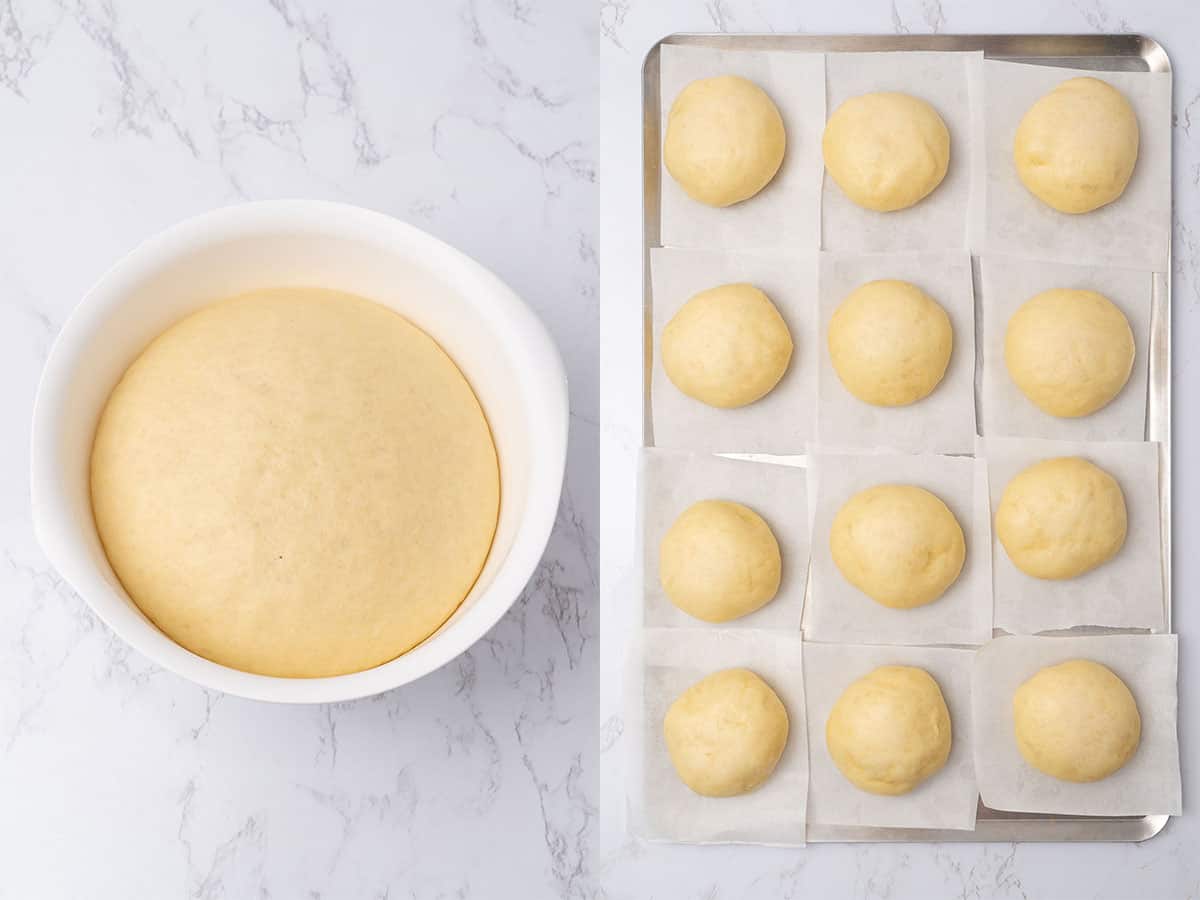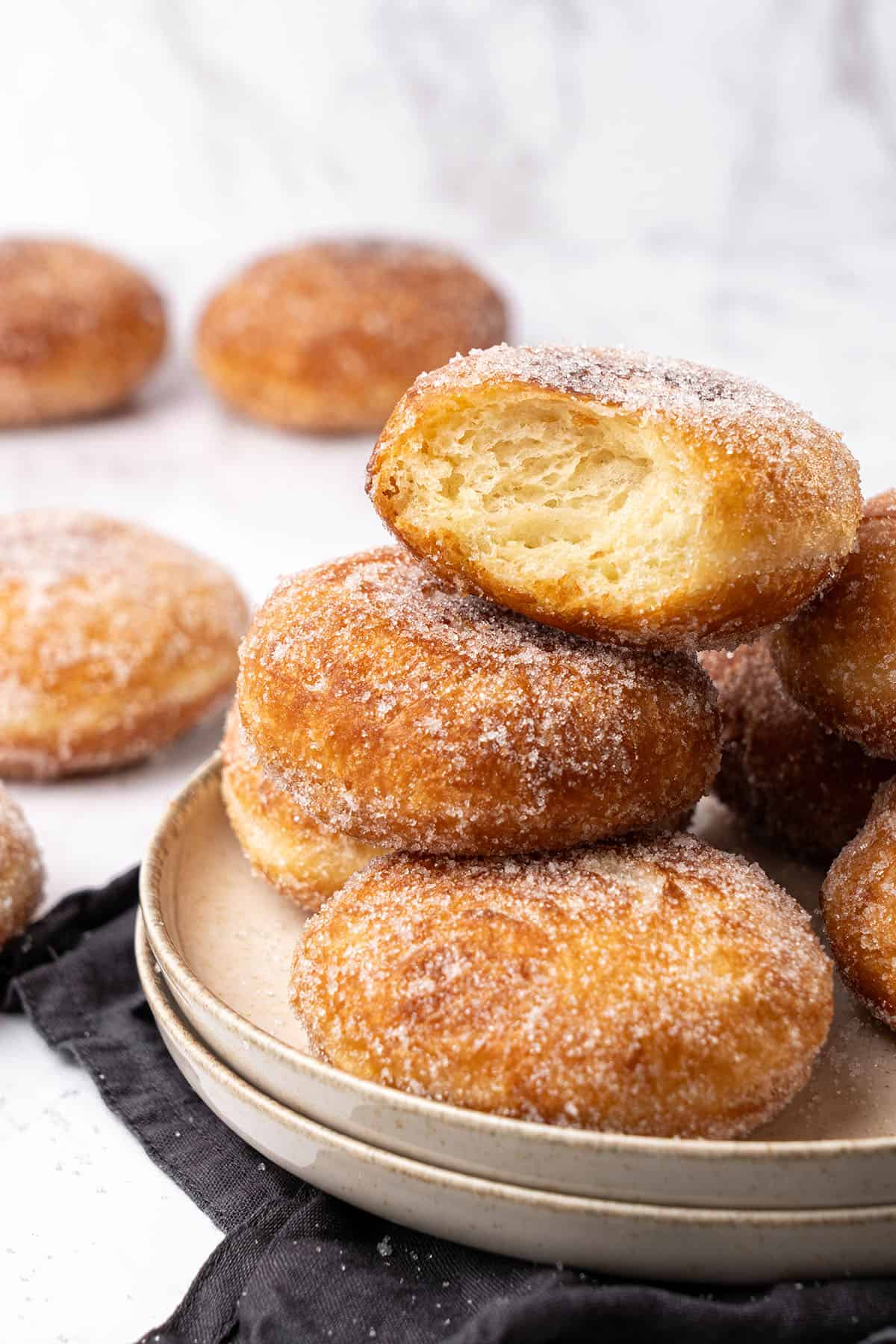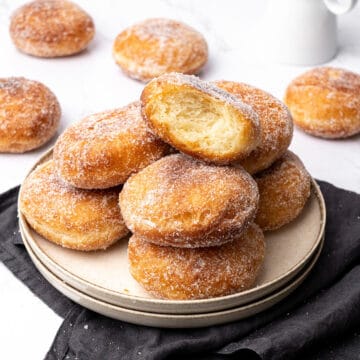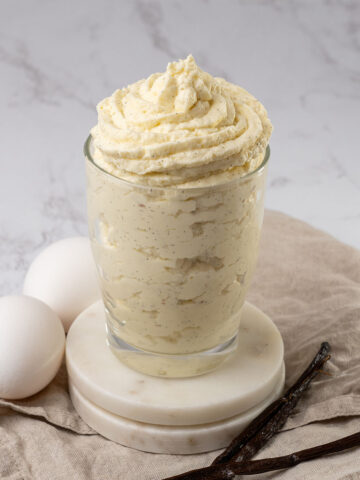Made with just eight simple ingredients you likely already have in your pantry, this easy brioche donut recipe is a breeze to make and the perfect addition to your breakfast or dessert menu. Believe me, when I say that these deep-fried, melt-in-your-mouth treats are so soft, fluffy, and buttery you may never return to eating regular donuts!

Jump to:
- 📖 What are Brioche donuts
- 💡 What is the difference between Brioche donuts vs. regular donuts
- 🌟 Why this is the best recipe
- 📝 Ingredient notes
- 👩🍳 How to make this recipe
- 📚 Flavor variations & Substitutions
- 📚 How to fill these brioche donuts
- 🥣 Equipment Notes
- 🎓 Expert tips
- ❓Recipe FAQs
- 🍩 More Donut recipes
- Brioche Donuts
📖 What are Brioche donuts
Brioche donuts are a type of fried donut made from French brioche dough, a yeast mixture enriched with butter, eggs, milk, and sugar. Because of their soft, fluffy, and airy dough and sweet flavor, brioche donuts are an excellent breakfast or dessert option.
Like regular donuts, you can top brioche donuts with sweet frostings and glazes or fill them with decadent creams, ganaches, or fruit compote.

💡 What is the difference between Brioche donuts vs. regular donuts
While brioche and regular donuts share similarities in the ingredients and you cook them, the difference lies in the quantities of those ingredients. Both donuts are fried and use cake-based ingredients such as flour, butter, sugar, eggs, salt, and milk. However, brioche bread uses more eggs and much more butter, giving it a fluffier pillowy texture and a more buttery flavor than regular donuts.
🌟 Why this is the best recipe
- It is the most delicious - I use the most high-quality ingredients and techniques to make the dough super light, fluffy, and buttery. It is just like my French Brioche bread but fried instead of baked. I also use more butter than most other bakers to give it even more flavor. I can confidently say this is the best brioche donut recipe you will try!
- No fancy ingredients or equipment required - There’s no need to go to a specialty store to make this brioche donuts recipe. All necessary ingredients are easy to find in your local grocery store and may already be in your pantry. Although a stand mixer makes kneading the dough much easier, you can knead by hand if you don’t have one.
- It is easy to follow - This step-by-step tutorial covers everything you need to know to make, shape, and fry the dough into perfect donuts. Just make sure to follow each step as written and follow my expert tips below.
- You won’t spend all day in the kitchen - The recipe itself only takes 30 minutes to prepare and with minimal effort. The longest part is waiting for the dough to proof, which you can do overnight.
- It is versatile - You can use the brioche dough to make numerous different desserts, such as my cinnamon apple babka or rum baba. You can also customize your donuts with various toppings and fillings, as I share in the Flavor Variations and Substitutions section below.
📝 Ingredient notes

- Milk - Use whole milk, preferably with 3% fat content. The milk needs to be lukewarm.
- Sugar - A small amount of granulated sugar is necessary to help sweeten the dough.
- Yeast - For the best results, use fresh yeast. You can also substitute with approximately 1.5 teaspoons (5g) of instant yeast. For more tips, see my guide on how to bake with yeast.
- Egg - You will need one whole egg and one egg yolk for the recipe to help add moisture to the dough. Both the whole egg and the yolk need to be at room temperature.
- Bread flour - Because this is essentially a sweet bread, you will need high protein content bread flour. If necessary, you can substitute with all-purpose flour, although the texture will not be as chewy.
- Salt - Salt is an essential ingredient in baking to help balance the sweetness and enhance the flavor.
- Butter - Always use unsalted butter when baking to control the amount of salt in the recipe. I use 82% fat-content European Butter in this recipe to give it the best flavor. The butter must be at room temperature to be soft enough to knead into the dough. Do not use melted butter, as it will not blend in with the dough.
- Oil - You will need vegetable oil or canola oil to fry the donuts.
🛒 You’ll find detailed measurements for all ingredients in the printable version of the Recipe Card at the bottom of this post
👩🍳 How to make this recipe
1. Step-by-step process of making the brioche dough
- Mix the sugar with the lukewarm milk, then sprinkle the yeast on top. Your kitchen needs to be nice and warm for the yeast to activate. In approximately 10 minutes, the yeast will start to foam.
- Place the yeast mixture into the stand mixer fitted with a kneading dough hook attachment, then mix the yeast with the room-temperature egg and egg yolk.
- Mix in the flour and salt (your dry ingredients) and knead until the dough comes together.
- Slowly add the soft room-temperature butter chunks, one piece at a time. Knead the dough on medium-high speed for an additional 10 minutes until the dough is elastic, shiny, and no longer sticks. If your dough is still wet and sticky, probably you need to knead it more.
- Place the dough into a bowl and cover it with plastic wrap or a tea towel. Let it sit at room temperature for 1-2 hours or in the refrigerator overnight.
💡 Top Tip: For the best texture and flavor, double-proof the dough, placing the dough in the fridge overnight for the first rise. The cold dough will be much less sticky and easier to work with than soft room-temperature dough.

2. How to shape the brioche doughnuts
- After the dough rises, press the air out. Then gently knead the dough for a few seconds and divide it into 12 pieces.
- Roll the 12 dough pieces into balls using your hands and place them onto a baking sheet with individual square sheets of parchment paper. Sprinkle the dough with a small amount of flour if necessary to prevent sticking.
- Cover and proof the dough a second time, this time at room temperature. This process could take 1-2 hours, depending on the temperature of your kitchen. While you must keep the dough in a warm place, avoid placing it near direct heat or sunlight.
💡 Top Tip: Use a digital scale to measure and ensure the dough pieces are equal in size. You can also use the rolling and cutting out method, though the pieces will not be as identical.

3. How to fry donuts
- Once the donuts have risen to a nice, puffy texture, heat the oil in a heavy-bottomed pan over medium heat. Use a digital thermometer to check that the temperature is between 347-365F / 175-185C, as the right temperature is critical to making flawless donuts. The ideal oil temperature is 356F/180C.
- Fry the donuts in batches, placing 3-4 donuts in the oil at a time. Each piece should have sufficient space around it. Fry the donuts on each side for approximately two minutes or until the color turns nice and brown.
- Move the fried donuts to a wire rack lined with paper towels to soak up any extra oil. Serve fresh. You can also top the donuts with your favorite toppings or fillings before serving. See the Flavor Substitutions and Variations section for more ideas!
💡 Top Tip: Add just enough oil to the pan to allow the donuts to float without touching the bottom. This amount will vary depending on what type of pan you use. You can also use a deep fryer if you have one available.

📚 Flavor variations & Substitutions
One of the best parts about these homemade brioche donuts is that they are incredibly versatile! You can enjoy them in many different ways: Plain, with toppings, with fillings, or converted into other fun recipes! Here are just a few variations you can try:
With toppings: Toss the donuts in granulated sugar or drizzle them with a glaze before serving. Try them with my decadent chocolate glaze or fruity blueberry glaze!
With fillings: Fill them with chocolate or vanilla cream or fruity fillings, such as pastry cream, Bavarian cream, lemon curd, apple pie filling, or even Nutella!
Similar recipes: Use the dough as a base for other delicious recipes, such as my walnut, apple, or Nutella babka, my moist rum baba, or my homemade French toast brioche.
With all-purpose flour: If necessary, swap out the bread flour for all-purpose flour at a 1:1 ratio. However, the donut texture will not be as soft and chewy.
With dry yeast: Substitute the fresh yeast with instant dry yeast. However, it is important to check the packaging for the correct amount of active dry yeast to substitute. Learn more about it in my yeast guide.
Without eggs: If you have an egg allergy, use one of the available egg substitutes to make this recipe. However, since the egg is a critical part of this recipe, you will likely need to make other adjustments to get the same flavor and texture.
📚 How to fill these brioche donuts
If you want to add tasty filling to the inside of your brioche donuts, you can do so with just a few simple steps:
- Once the freshly fried donuts have cooled to room temperature, poke a small hole in one side using a chopstick or knife. You may need to gently rotate the chopstick or knife to widen the inside of the donut enough to add the filling.
- Spoon your filling of choice into a piping bag fitted with a round tip.
- Insert the piping bag tip into the donut’s hole and gently squeeze the filling inside. Do not fill it too fast, or it may not fill the air pockets in the donut.
- Once filled, top it with your favorite toppings (optional) and serve.
Choose your favorite fillings:
🥣 Equipment Notes
Always use a digital scale for the most accurate and consistent measurements. Likewise, a digital thermometer ensures the oil is at the proper temperature range for frying the donuts.
A stand mixer helps knead the dough, although not 100% necessary. If you don’t mind the arm workout, you can use your hands instead! If using the rolling and cutting out method to make donuts with a hole in the middle, you will need a rolling pin to press the dough to the appropriate thickness.
🎓 Expert tips
- The eggs, milk, and butter must be at room temperature for the ingredients to emulsify properly.
- You must always activate the yeast first until it is foamy. Activating the yeast will require that your kitchen must be nice and warm. However, avoid placing the dough near direct heat or sunlight.
- For ease of handling the dough, you should ideally do the first proofing overnight in the refrigerator. Do not skip the second proofing, as it is necessary to give the donuts the perfect rise and texture.
- When kneading the dough, do not attempt to adjust the ingredients or add more flour to achieve a shiny and elastic result quicker. If the dough sticks, continue kneading until it reaches the gluten window and can pass the windowpane test.
- Monitor the oil temperature to ensure it is not too hot or too cool. The oil that is too hot will burn the outside of the donuts while the inside remains raw and undercooked. Oil that is too cool will soak up too much oil while the inside remains raw and undercooked.

❓Recipe FAQs
Store the donuts in an airtight container at room temperature for up to two days. You can also place them in the refrigerator to preserve their freshness, but they may lose some texture. To warm them up, put them in the microwave for a few seconds.
You can freeze Brioche donuts for up to a month. Once completely cooled, wrap each donut in aluminum foil and place them in the freezer. To thaw, let them sit at room temperature. Reheat for a few seconds in the microwave.
Technically, yes. However, air frying the donuts will not give you the same golden brown color or delicious deep-fried flavor that makes them so tasty!
If you prefer not to deep fry the donuts, you can make baked brioche donuts by placing them in the oven at 350F / 180C for approximately 15-20 minutes. However, they will be less crispy on the outside and not have a deep-fried flavor, more like regular brioche.
While I have not tested the vegan version of this recipe, I have seen other bakers replace the milk and butter with plant-based milk and vegan butter or margarine and omit the eggs to make vegan donuts. However, since eggs and butter are the heart of this brioche bread, you will likely need to adjust the other ingredients to achieve the same flavor and texture.
The dough used to make malasada is much wetter and softer due to the increase in eggs and the use of evaporated milk. The result is a sweeter, softer, and even more pillowy dough.
🍩 More Donut recipes

Brioche Donuts
Equipment
- Digital scale
Ingredients
Donut Dough
- 110 g (½ cups) Whole milk lukewarm
- 50 g (¼ cups) Granulated sugar
- 12.5 g Fresh yeast Can be substituted with 5g (1.5 teaspoons) instant yeast
- 1 Egg yolk room temperature
- 1 Egg room temperature
- 250 g (2 cups) Bread flour High protein content flour. Can be substituted with all-purpose flour.
- ¼ teaspoon Salt
- 120 g (½ cups) Unsalted butter room temperature, soft
For frying
- 1.5 liter (6 cups) Vegetable or Canola oil for frying
US customary cup measurement is an indicative figure only. Measure the ingredients with a digital scale by weight (gram). Baking is art but also science which requires precision and accuracy.
Instructions
Prepare the dough
- Start with mixing sugar with lukewarm milk then sprinkle yeast on top. Make sure the kitchen is nice and warm, and in 10 minutes the yeast should foam.
- Place the yeast mixture into your Stand mixer with the kneading hook on, then mix it together with the egg and egg yolk.
- Mix in dry ingredients; flour, and salt, and start kneading until the dough comes together.
- Slowly start to add in room temperature (soft) butter chunks piece by piece. Knead the dough for another 10 minutes on medium high speed until the dough becomes elastic and shiny and not sticky any longer.
- Move the dough into a bowl and cover it with plastic wrap or a tea towel. Let it rise ideally in the fridge overnight or at room temperature for 1-2 hours.
- After the dough has risen, knock the air out, gently knead the dough for a few seconds and divide it into 12 using a digital scale.
- Form 12 balls with your hand and place them into square sheets of baking paper. Use a small amount of extra flour while shaping the dough, if needed.
- Proof the dough for the second time now at room temperature. Proofing might take 1-2 hours depending on the temperature of your kitchen. Chose a warm spot but avoid direct heat and sunlight.
- Once the donuts are nicely puffed up, heat vegetable oil in a heavy-bottomed pan over medium heat. The ideal oil temperature for baking donuts is 180C/356F or between 175-185C / 347-365F. Use a thermometer.
- Depending on the size of your pan, place 3-4 donuts in the oil at a time, leaving enough space around them. Fry the donuts on each side for about 2 minutes or until nice and brown.
- Place the fried donuts on a wire rack lined with paper towels to soak up any excess oil. Serve them fresh. Optionally, toss the donuts in granulated sugar or fill them with your favorite fillings eg. Nutella, jam, Bavarian cream, Pastry cream, etc.
- Store the donuts in an air-tight container at room temperature for 1-2 days. Due to the butter content, these donuts will stay fresh longer, however, you can also warm them up for a few seconds in the microwave.
Notes
- Use always unsalted butter in baking, in this recipe butter needs to be at room temperature so soft enough to be able to knead into the dough
- Fresh or Dried yeast can be used. Please check my baking guide for more details on how to bake with yeast.
- Use the milk, butter and egg at room temperature in order for the ingredients to properly emulsify
- Since rum donut is effectively a sweet bread, use high protein content bread flour
- For activating the yeast (whether it is dried or fresh), make sure that the milk is lukewarm and your kitchen is also nice and warm
- You will knead the dough for about 10 minutes in a stand mixer. The dough is ready when it is shiny, elastic, and does not stick to your fingers any longer. Do not add more flour to the dough. If it sticks too much, continue kneading
- The first proofing ideally should happen in the fridge overnight for the best flavor and texture. It will also mean that you work with a cold dough when shaping the donuts which is less sticky and easier to shape.
- Second proofing is necessary for the perfect rise = fluffy texture
- The oil temperature is critical, use a thermometer. Too hot? It will burn the donuts and they might stay raw in the middle. Too cold? The donuts will soak in too much oil and again, might stay raw in the middle.










Joshua
Do I proof the dry yeast in the water like your article says in "Bake with Yeast" before adding it to the Milk and Sugar or do I add the dry yeast directly to the Milk and Sugar. I'm not using Fresh Yeast.
Katalin Nagy
You should add the yeast as explained in this particular donut recipe whether using fresh or dry.
Diann
Can I substitute active dry yeast? How much will be the ratio?
Katalin Nagy
Yes pls see my yeast article for more details https://www.spatuladesserts.com/bake-with-yeast/
dave
Excellent recipe! I've had this same receipe for years and make these almost every month. Our family loves to enjoy them with meals, watching TV, in bed, or even outside on the patio. I find them very easy to make and usually fill them with pudding or cream cheese, after I deep fry them. I put the filling in before deep frying a few times and learned it's better to do it after, as long as they're still hot and right out of the deep fryer. You don't want them to set up and get hard before filling them. I use a large caulking gun to inject the filling as deep as possible so I can get a lot inside them.